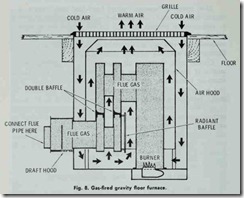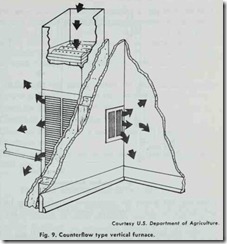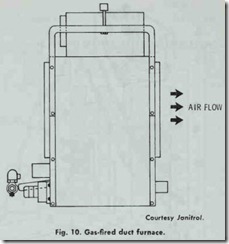PIPELESS, FLOOR AND WALL FURNACES
A pipeless furnace (Fig. 8) is commonly a gravity warm-air furnace installed in a central location beneath the floor. A single grille for the warm air and a return is provided for air circulation. This type of pipeless furnace is sometimes referred to as a floor furnace, although the latter is actually a permanently installed room heater and should be distinguished as such. Wall furnaces also belong to this category.
Both gas- and oil-fired furnaces are manufactured for instal lation in recesses cut from the floor. They are available in a wide range of Btu ratings for different types of installations. Some are thermostatically equipped for automatic temperature control and with blowers for forced air circulation (although those that oper ate on the gravity principle of air circulation are more common). There is also a choice between electric ignition or pilot flame. All gas-or oil-fired floor furnaces must be vented.
Another type of pipeless furnace is the gas- or oil-fired vertical furnace installed in a closet or a wall recess. The counterflow types discharge the warm air from grilles located at the bottom of the furnace as shown in Fig. 9.
DUCT FURNACES
A duct furnace (Fig. 10) is a unit heater designed for instal lation in a duct system where a blower (or blowers) is used to circulate the air. They are commonly designed to operate on natural or propane gases, although electric duct heaters are also available (see Chapter 7, Volume 2).
FURNACE INSTALLATION
No attempt should be made to install a warm-air furnace until you have consulted the local codes and standards. The American Gas Association and the National Fire Protection Association have also established codes for the installing of warm-air furnaces which they have made available to ,the public through their publi cations (see, for example, NFPA No. 31 “Installation of Oil Burning Equipment 1972″ , NFPA No. 90B “Residence Warm Air Heating 1971″, NFPA No. 204 “Smoke and Heat Venting 1968″, etc.). These publications can be obtained free or at a modest price from these organizations. Their addresses appear in Appendix A (PROFESSIONAL AND TRADE ASSOCIA TIONS) of this book.
As soon as the heating equipment is shipped to your building site or existing structure, check it for missing or damaged parts. The manufacturer should be notified immediately of any dis crepancies so that replacements can be made.
Follow the manufacturer’s instructions for installing the heat ing equipment, but give precedence to local codes and regulations should any conflict appear. Most manufacturers base their in stallation instructions on existing codes formulated by the Ameri can Gas Association and the National Fire Protection Association.
Locate the furnace so that it has the shortest possible flue run containing as few elbows (turns in the run) as possible. Clearances around the furnace should be kept to the required mmtmum, but within the regulations established by local codes and standards. Air ventilation must be adequate for efficient operation.
After the furnace has been installed, check all gas or oil lines for possible leaks. Make the necessary repairs if any leaks are found.
More detailed instructions for installing furnaces are found in Chapter 11 (GAS-FIRED FURNACES), Chapter 12 (OIL FIRED FURNACES), Chapter 13 (COAL-FIRED FUR NACES), and Chapter 14 (ELECTRIC-FIRED FURNACES).
FURNACE MAINTENANCE
Furnace maintenance is a very important part of the efficient operation of a warm-air heating system and should never be neglected.
The manufacturer of the heating equipment will provide rec ommendations for proper maintenance, and these recommenda tions should be carefully followed. By doing so, you will extend the life of the equipment, improve its efficiency, and reduce op erating costs.
Maintenance recommendations specific to gas-fired, oil-fired, coal-fired, and electric-fired furnaces are included in the appro priate chapters (see, for example, Chapter 11. GAS-FIRED FURNACES, etc.). Certain maintenance recommendations are general in nature and will apply to any type of furnace regardless of the fuel used. These general maintenance recommendations are as follows:
1. Always read and closely follow the manufacturer’s main- tenance instructions (if they are available).
2. Check gas and oil pipes for leaks.
3. Check and clean (or replace) air filters.
4. Clean the furnace once a year (preferably before the heat ing season starts).
5. Oil the motor of a gas or oil burner two to three times each year.
GENERAL TROUBLESHOOTING HINTS
Each type of equipment described in this book contains a troubleshooting section in which problems specific to that type of equipment are discussed. A complaint common to all types of heating systems is that the system will not deliver heat. Because this is a troubleshooting problem that is general in nature, rec ommended corrective procedures will b.e included in this section.
The first thing that should be done if the system fails to de liver heat is to check the fuse box. Many times the whole problem can be traced to a blown fuse. By simply replacing it, you will save the cost of a service call. By the way, do not look at the manufacturer’s name on the room thermostat and call the nearest factory or representative. Thermostat manufacturers do not make furnaces! If the fuse box does not contain the problem, then check the following:
1. Make certain the power is on at the main switch.
2. Make certain the burner motor fuse is not blown.
3. Check the burner on-off switch (if the switch is off, make sure the combustion chamber is free of fuel or fuel vapors. then turn the switch to ON position).
4. Check the fuel supply.
5. Make certain all manual valves are open.
6. Make certain the limit switches are closed.
7. Reset the safety switch and set the thermostat to call for heat.


